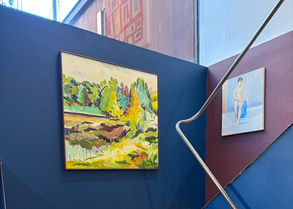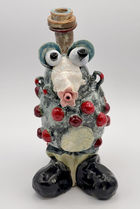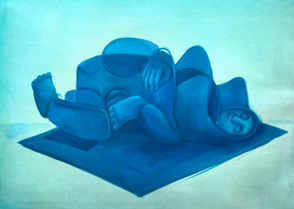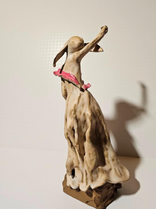Alex Callender

My current work proposes an alternative Atlantic history, performed in scenes by women channeled from colonial painting imagery. Remixing the works of Agostino Brunias, an 18th-century painter who depicted (for European audiences) various scenes of daily life and social class in the Caribbean, I reconstruct parts of these works to explore representations of gender, racialization, and the development of consumer buying power as a primary marker of identity. My interest in using historical source material is not to reanimate the past, but to consider how artworks that “naturalize” certain types of people (women, people of color, and migrants) to representations of cultural assimilation, are often depicting economic narratives that attempt to normalize inequity and invisible labor.
When I first approached Brunias’ work as source material, I considered the works as speculative narrative that he projects onto the lives of the women in his paintings. The use of the market place, and the road between plantations are primary in his work. These scenes conceal the intimacies of families split apart through slavery by demonstrating an incidental “country road” where all families meet, those just freed and those still condemned to enslavement and servitude meeting without apparent estrangement. In my current projects I disrupt Brunias’ market scenes of daily life by changing economic speculation into speculative histories, in which these women enact an alternative history and become a collaborative body. Through drawn works, I investigate the historical lineages of drawing and the avatar as a political tool. In these drawn works I reference tableaus from the Bresil Panoramiques, and French panoramic wallpapers, which were a feature of Victorian luxury home design, and would often depict scenes originally drafted as ethnographic studies, or travelogues by colonial Europeans abroad, re-presenting people who existed on the margins of colonial time. This panoramic imagery was a way of transporting people as ideas, or avatars through time, and into a commodity form, one comingled with Western political imagination of gender and race.
My process uses some variation of paint media, cut paper, layered drawing techniques, and distilling images through GIS (Geographic Information System) mapping software. In mapping a painting, which does not actually have a real locality, the software through its algorithms, oddly reveals the fractured nature of the landscape inside. Draining the landscape of the idyllic pictorial nature that emphasizes traditions of Western-style Grand Tour Scenic painting found in Brunias’ work, and inserting a grid instead I allow the viewer to see the construction of an ideological space poised behind these paintings. In the grid I choose color systems of contemporary hyper consumption, neon that speaks to the surface of plastics, pantone color, and digital landscapes, to amplify the idea of a historical hybridity, in which the past and the present are occurring in the same space and attempting to alter one another.




































